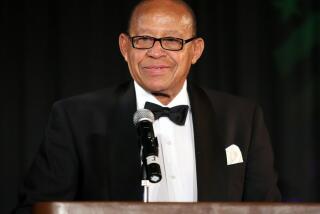Rowland B. Wilson, 74; Playboy Cartoonist, Disney Animator
- Share via
Rowland B. Wilson, cartoonist for such magazines as Playboy, Esquire and the New Yorker who also worked as an animator on Disney projects, including “The Little Mermaid,” has died. He was 74.
Wilson of La Costa died June 28 of heart failure at Scripps Memorial Hospital in Encinitas.
As an animator, Wilson won a daytime Emmy Award in 1980 for his work on ABC’s “HELP! Dr. Henry’s Emergency Lessons for People” and worked on educational animation, including the television series “Schoolhouse Rock.”
In 1975, Wilson won awards at the Venice and Irish Animation festivals, and his animated commercial film “The Trans-Siberian Express” won first prize at the third International Animation Festival in New York. He also won a Clio.
He worked for Walt Disney Feature Animation as a visual developer and served as a layout designer for “The Little Mermaid” in 1989. He also contributed to “The Hunchback of Notre Dame” and “Tarzan” among others.
But Wilson’s greatest legacy may be on the printed page. His cartoons, widely published in magazines, were reprised in several anthologies, beginning with “Don’t Fire Until You See the Whites of Their Eyes,” a collection of his Esquire work published in 1963. He earned Playboy’s Cartoonist of the Year award in 1982 and his work was included in the 2004 anthology “Playboy -- 50 Years: The Cartoons.”
For all Wilson’s love of animation, “It was sketches for a new Playboy cartoon that were on his drawing board when he died,” said his daughter Megan Wilson.
Wilson also worked extensively in advertising and was particularly lauded for his 40 or so humorous works for New England Mutual Life Insurance Co. Each cartoon-type ad depicted a person in dire straits -- such as an executive with his back to a high-rise office window as a wrecking ball swings toward him, proclaiming, “My life insurance company? New England Life, of course. Why?”
Born Aug. 3, 1930, in Dallas, Rowland Bragg Wilson grew up drawing Disney characters at the kitchen table. He received a bachelor’s of fine arts from the University of Texas at Austin and then moved to New York City for graduate work at Columbia University.
To support himself, he began creating gag cartoons for the Saturday Evening Post, Collier’s, Look and True magazines. He was drafted into the Army, serving from 1954 to 1956, where he used his artistic talents to draw classified charts.
In 1957, Wilson joined the Young & Rubicam Inc. advertising agency where he spent seven years as an art director, doing conceptual drawings for print ads.
At the same time he stepped up his freelancing of cartoons to magazines and became a regular with Esquire in 1958. In the late ‘50s and early ‘60s he also had cartoons published in the New Yorker.
He established himself as a freelance advertising artist in 1964 but never gave up cartooning, which he described as “picture writing.” Forced by his lucrative advertising contracts to limit cartoon work to a single magazine, he focused on Playboy after Esquire abandoned its full-page cartoons.
In 1967, he also drew “Noon,” a short-lived comic strip for the New York News-Chicago Tribune Syndicate (Tribune Corp. now owns the Los Angeles Times).
As Wilson once described the strip, “The name of the main character was Noon Ringle, an unemployed cowboy in a dying small Texas town in sort of modern times.”
Wilson illustrated two children’s books in the early ‘70s, “Tubby and the Lantern” and “Tubby and the Poo-Bah.”
It was advertising that moved him into animation, and from 1973 to 1975 he worked in London as a designer for the primarily commercial animation studio of Richard Williams. On his return to New York, he joined Phil Kimmelman and Associates, which concentrated mainly on advertising work.
In his cartoons, advertisements, designs for animated characters and illustrations, Wilson was known for three-dimensional drawings filled with historical detail.
“Ideas are easy to come by,” he often said, according to his daughter. “It is the drawing that takes a long time.”
Wilson’s first marriage to Elaine Libman ended in divorce. He is survived by his second wife, artist Suzanne Lemieux Wilson; four daughters, who are all commercial artists, Amanda Wilson of Piermont, N.Y., Reed Wilson of London, Kendra Wilson of Leicestershire, England, and Megan of New York City; and three grandchildren.
More to Read
The biggest entertainment stories
Get our big stories about Hollywood, film, television, music, arts, culture and more right in your inbox as soon as they publish.
You may occasionally receive promotional content from the Los Angeles Times.










